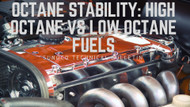Octane Stability: High Octane vs Low Octane Fuels
By on Nov 22 2018
Octane is the most talked about property when it comes to gasoline. It’s no surprise because selecting octane of gasoline is the only choice the consumer has, except what station to buy it from. In this article we will focus on octane stability of 87 and 93 octane pump fuels versus racing fuels and what you can do to prevent octane loss in your fuel.
It is necessary to briefly review what octane is in order to dive deeper into stability issues. At fueling stations in the United States, octane is typically displayed as a number, 87 through 93. This number is known as Anti-Knock Index (AKI). AKI is the average of Research octane number (RON) and Motor octane number (MON)(Totten). Essentially, these numbers provide a scale to measure how much heat and pressure can be put on the fuel before it spontaneously combusts. Spontaneous combustion is a source of engine knock which can quickly damage an engine. Octane ratings are important because different engines expose fuel to different amounts of pressure and heat. Engines must use the proper octane fuel to avoid knock and provide reliable operation.
A key aspect of gasoline stability is vapor pressure. This is determined by how much pressure builds up inside a sealed fuel container when the fuel is heated to 100°F. A higher vapor pressure suggests a higher concentration of low boiling point hydrocarbons that vaporize under 100°F. Pump fuels with high (12 pounds/square inch, psi) vapor pressures are used in cold weather to prevent engine starting issues due to low temperatures. Pump fuels are limited to 7.8-9psi maximum in warm weather depending on county and state (www.epa.gov). If stored in a vapor tight container the vapor pressure can be maintained for long periods of time. Fuel exposed to the atmosphere can lose light components within a couple of days. Over time as vapor pressure decreases the fuel can become stale. Stale fuel doesn’t evaporate as easily and can cause rough engine idle and hard starting. Butane is a volatile gasoline component used to tailor vapor pressure in accordance with seasonal needs. Cold weather fuel has higher concentrations of butane. Butane has a high blending octane value which helps manufacturers hit their octane targets. The main downfall of butane is that it boils at 32°F. If the fuel tank is vented to atmosphere the butane can start to evaporate out unless the daily temperatures are below freezing. This makes cold weather fuel more susceptible to vapor pressure loss and octane decreases.
87 octane fuels tend to be less refined and contain more unstable hydrocarbons. As the months pass during storage these unstable components react to form gums, varnishes and lower octane hydrocarbons. As a result the octane can decrease within months for 87 octane fuels, especially when stored under less than ideal conditions. 93 octane fuels are more refined and contain more stable hydrocarbons. These stable hydrocarbons can last 2-3 times longer than 87 octane fuel. Even in proper storage 87 octane gas can start to degrade in 3 months, 93 octane fuel should last closer to 9 months before degradation is noticeable. Keep in mind that 93 octane fuels are still susceptible to octane loss and vapor pressure decreases due to butane evaporation.
Octane stability in racing fuels is much different because fuel quality is valued more than production cost, unlike the pump gas industry where cost drives the majority of refining decisions. A large part of any quality race fuel is consistency. Race fuels are designed to be high in octane to allow for increased compression ratios and boost levels. In order to achieve high octane and consistent composition, pure chemical components are mixed with highly refined gasoline. The components used in Sunoco race fuels are very stable and can retain octane in excess of 2 years when properly stored. We have test results confirming octane stability in our unleaded, leaded, ethanol-free and ethanol fuels. The butane vapor pressure issue is addressed with the use of chemical components that boil around 80°F. The higher boiling point means vapor pressure decreases won’t be as common until the fuel is exposed to temperatures above 80°F.
Some high octane unleaded fuels, 260 GT Plus, and octane boosters contain the additive MMT. MMT is a very effective octane booster and doesn’t harm oxygen sensors or catalytic converters so, it is ideal for modern vehicles. Please note this additive is degraded by sunlight and can lose all octane boosting properties within minutes of exposure (L.Ter Haar). Degraded MMT will settle to the bottom of the container as a rust colored material that can clog fuel lines and filters. Extra care needs to be used when storing and handling MMT fuels in order to minimize contact with sunlight. The additive is stable in gasoline as long as no UV light hits the fuel. Sunoco 260 GT Plus is our only race fuel that contains MMT.
Octane stability is greatly affected by the storage conditions. Proper storage can preserve octane for years but improper storage can reduce octane and degrade fuel within weeks. That is why we provide proper storage information on our website. Click here to view our storage recommendations. http://www.sunocoracefuels.com/tech-article/race-fuel-storage
Special thanks goes to Minnesota State University Mankato, Automotive Engineering Technology students for suggesting the topic of this article.
Author:
Zachary Santner
Technical Specialist
Sunoco Race Fuels
Resources:
- Totten, George E., Steven R. Westbrook, and Rajesh J. Shah. Fuels and lubricants handbook: technology, properties, performance, and testing. West Conshohocken, PA: ASTM International, 2003. Print.
- https://www.epa.gov/gasoline-standards/gasoline-reid-vapor-pressure
- L. Ter Haar , M. E. Grifffing , M. Brandt , D. G. Oberding & M. Kapron (1975) Methylcyclopentadienyl Manganese Tricarbonyl as an Antiknock: Composition and Fate of Manganese Exhaust Products, Journal of the Air Pollution Control Association, 25:8, 858-859, DOI: 10.1080/00022470.1975.10470152






